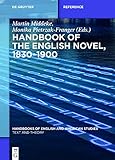Handbook of the English Novel, 1830–1900 / ed. by Martin Middeke, Monika Pietrzak-Franger.
Material type: TextSeries: Handbooks of English and American Studies : Text and Theory ; 9Publisher: Berlin ; Boston : De Gruyter, [2020]Copyright date: ©2020Description: 1 online resource (X, 676 p.)Content type:
TextSeries: Handbooks of English and American Studies : Text and Theory ; 9Publisher: Berlin ; Boston : De Gruyter, [2020]Copyright date: ©2020Description: 1 online resource (X, 676 p.)Content type: - 9783110376418
- 9783110394214
- 9783110376715
- online - DeGruyter
- Issued also in print.
| Item type | Current library | Call number | URL | Status | Notes | Barcode | |
|---|---|---|---|---|---|---|---|
 eBook
eBook
|
Biblioteca "Angelicum" Pont. Univ. S.Tommaso d'Aquino Nuvola online | online - DeGruyter (Browse shelf(Opens below)) | Online access | Not for loan (Accesso limitato) | Accesso per gli utenti autorizzati / Access for authorized users | (dgr)9783110376715 |
Frontmatter -- Editors’ Preface -- Contents -- 0. Metamorphoses in English Culture and the Novel, 1830–1900: An Introduction -- Part I: Systematic Questions -- 1. Science and the Victorian Novel -- 2. Remediating Nineteenth-Century Narrative -- 3. God on the Wane? The Victorian Novel and Religion -- 4. Genres and Poetology: The Novel and the Way towards Aesthetic Self-Consciousness -- 5. The Art of Novel Writing: Victorian Theories -- 6. Victorian Gender Relations and the Novel -- 7. Empire – Economy – Materiality -- Part II: Close Readings -- 8. Thomas Carlyle, Sartor Resartus (1833–1834) -- 9. Benjamin Disraeli, Sybil, or The Two Nations (1845) -- 10. Charlotte Brontë, Jane Eyre (1847) -- 11. Emily Brontë, Wuthering Heights (1847) -- 12. Anne Brontë, Agnes Grey (1847) -- 13. William Makepeace Thackeray, Vanity Fair (1847–1848) -- 14. Elizabeth Cleghorn Gaskell, Mary Barton (1848) -- 15. Charles Kingsley, Yeast: A Problem (1851) -- 16. Charles Dickens, Bleak House (1853) -- 17. Anthony Trollope, Doctor Thorne (1858) -- 18. Mary Elizabeth Braddon, Lady Audley’s Secret (1862) -- 19. Lewis Carroll, Alice’s Adventures in Wonderland (1865) -- 20. Wilkie Collins, The Moonstone (1868) -- 21. Edward Bulwer-Lytton, The Coming Race (1871) -- 22. George Eliot, Middlemarch (1871–1872; 1874) -- 23. George Meredith, The Egoist (1879) -- 24. Walter Pater, Marius the Epicurean (1885) -- 25. Robert Louis Stevenson, Strange Case of Dr. Jekyll and Mr. Hyde (1886) -- 26. Oscar Wilde, The Picture of Dorian Gray (1891) -- 27. Sarah Grand, The Heavenly Twins (1893) -- 28. George Moore, Esther Waters (1894) -- 29. Mona Caird, The Daughters of Danaus (1894) -- 30. Thomas Hardy, Jude the Obscure (1895) -- 31. H. G. Wells, The Time Machine (1895) -- 32. Bram Stoker, Dracula (1897) -- 33. Henry James, What Maisie Knew (1897) -- 34. Joseph Conrad, Lord Jim (1900) -- 35. Rudyard Kipling, Kim (1900–1901) -- 36. Samuel Butler, The Way of All Flesh (1903) -- Index of Subjects -- Index of Names -- List of Contributors
restricted access online access with authorization star
http://purl.org/coar/access_right/c_16ec
Part I of this authoritative handbook offers systematic essays, which deal with major historical, social, philosophical, political, cultural and aesthetic contexts of the English novel between 1830 and 1900. The essays offer a wide scope of aspects such as the Industrial Revolution, religion and secularisation, science, technology, medicine, evolution or the increasing mediatisation of the lifeworld. Part II, then, leads through the work of more than 25 eminent Victorian novelists. Each of these chapters provides both historical and biographical contextualisation, overview, close reading and analysis. They also encourage further research as they look upon the work of the respective authors at issue from the perspectives of cultural and literary theory.
Issued also in print.
Mode of access: Internet via World Wide Web.
In English.
Description based on online resource; title from PDF title page (publisher's Web site, viewed 25. Jun 2024)


